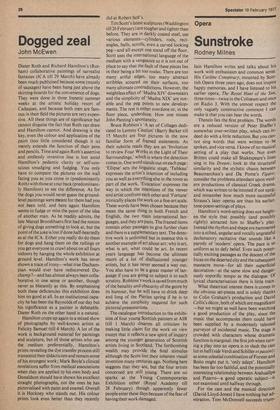Dogged zeal
John McEwen
Dieter Roth and Richard Hamilton's (Rotham) collaborative paintings of surrealist fantasies (ICA till 29 March) have already been much publicised because some (mostly of sausages) have been hung just above the skirting-boards for the convenience of dogs. They were done in three frenetic summer weeks at the artistic holiday resort of Cadaques, and because both men are famous in their field the pictures are very expensive. All these things are of significance but cannot disguise the fact that Roth can draw and Hamilton cannot. And drawing is the key, even the colour and application of the paint (too little considered though it is) merely extends the function of their pens and pencils. Time and again Roth's assertive and endlessly inventive line is lost amid Hamilton's pedantic clarity or self-conscious smudging and fudging. You only have to compare the pictures on the wall facing you as you come in (predominantly Roth) with those at your back (predominantly Hamilton) to see the difference. As for the dogs you would never guess the groundlevel paintings were meant for them had you not been told, and here again Hamilton seems to fudge or miss the point of the idea of another man. As he readily admits, the late Marcel Broodthaers first had the notion of giving dogs something to look at, but the point of the joke is lost if done half-heartedly as at the ICA. Either you really do do them for dogs and hang them on the railings or you get everyone to crawl about on all fours indoors by hanging the whole exhibition at ground level. Hamilton's work has never shown a trace of irony—what true Duchampian would ever have rediscovered Duchamp ?—and has almost always been collaborative in one sense or another, though never as blatantly as this. By emphasising both these deficiencies this exhibition does him no good at all. In an institutional capacity he has been the Reynolds of our day but his significance as a painter is debatable. Dieter Roth on the other hand is a natural.
Hamilton crops up again in a mixed show of photographs by well-known artists at Felicity Samuel (till 4 March). A lot of the work is background material for paintings and sculpture, but of those artists who use the medium preferentially, Hamilton's prints revealing the dye transfer process still transcend their didacticism and remain some of his strongest work; Mark Boyle's clinical revelations suffer from medical associations when they are applied to his own body and Donaldson should have shown his excellent straight photographs, not the ones he has pictorialised with paint and enamel. Overall it is Hockney who stands out. His colour prints look even better than they recently did at Robert Self's.
Tim Scott's latest sculptures (Waddington till 26 February) are tougher and tighter than before. They are in darkly coated steel, use various elements—cylinders, rods, rectangles, balls, scrolls, even a carved looking peg—and all except one stand off the floor. Scott uses the international language of the medium with a vengeance so it is not out of place to say that the fault of these pieces lies in their being a bit too votdus. There are too many artful edges, too many abstract scribbles scoured on their surfaces, too many ultimate contradictions. However, the weightless effect of 'Mudra XIV' downstairs and the simplicity of 'Mudra XIX' are notable and the peg points to new developments. The rest is either overdone or, in the floor piece, underdone. How one misses John Panting's spontaneity.
Bruce Robbins's 'A set of Collages dedicated to Lemmy Caution' (Barry Barker till 15 March) are four pictures in the now familiar form of framed statements. As their subtitle reads they are an 'Invitation to review Four Works in the Light of Their Surroundings,' which is where the detection comes in. One word stands out on each page: 'Ellipse' sets the linguistic stage, 'Tableau' expresses the artist's intention of including you as well as everything else in the room as part of the work, 'Evocation' expresses the way in which the intentions of the viewer and artist confront each other and 'Fortune' ironically places the work on a fine-art scale. These words have been chosen because they mean the same thing in both French and English, the two main international languages, and they are puns. The framed items contain other passages to give further clues and there is a supplementary text. The detective work is unlimited but in essence this is another example of art about art : why is art, what is art, what could be art. In recent years language has become the ultimate resort of a lot of disillusioned younger artists, but it has never seemed a way out. You also have to be a great master of language if you are going to subject it to such scrutiny. Robbins's work is saved from much of the banality and obscurity of the genre by its humour, but he will have to drink deep and long of the Pierian spring if he is to achieve the simplicity required for such pictorial presentations.
The catalogue introduction to the exhibition of four young Scottish painters at AIR (till I March) disarms all criticism by making little claim for the work on view except that it reflects a new spirit of inquiry among the younger generation of Scottish artists living in Scotland. The forthcoming wealth may provide the final stimulus although the Scots lost their inherent visual invention many centuries ago. Nothing here suggests that they are, but the four artists concerned are still young. There are no sparks at the Young Contemporaries Exhibition either (Royal Academy till 28 February) though apparently fewer people enter these days because of the fear of having their work damaged.


































 Previous page
Previous page